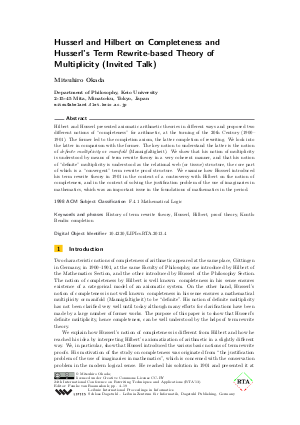Husserl and Hilbert on Completeness and Husserl's Term Rewrite-based Theory of Multiplicity (Invited Talk)
Author Mitsuhiro Okada
-
Part of:
Volume:
24th International Conference on Rewriting Techniques and Applications (RTA 2013)
Part of: Series: Leibniz International Proceedings in Informatics (LIPIcs)
Part of: Conference: International Conference on Rewriting Techniques and Applications (RTA) - License:
 Creative Commons Attribution 3.0 Unported license
Creative Commons Attribution 3.0 Unported license
- Publication Date: 2013-06-24
File

PDF
LIPIcs.RTA.2013.4.pdf
- Filesize: 0.53 MB
- 16 pages
Document Identifiers
Subject Classification
Keywords
- History of term rewrite theory
- Husserl
- Hilbert
- proof theory
- Knuth-Bendix completion
Metrics
- Access Statistics
-
Total Accesses (updated on a weekly basis)
0Document
0Metadata
Abstract
Hilbert and Husserl presented axiomatic arithmetic theories in different ways and proposed two different notions of 'completeness' for arithmetic, at the turning of the 20th Century (1900-1901). The former led to the completion axiom, the latter completion of rewriting. We look into the latter in comparison with the former. The key notion to understand the latter is the notion of definite multiplicity or manifold (Mannigfaltigkeit). We show that his notion of multiplicity is understood by means of term rewrite theory in a very coherent manner, and that his notion of 'definite' multiplicity is understood as the relational web (or tissue) structure, the core part of which is a 'convergent' term rewrite proof structure. We examine how Husserl introduced his term rewrite theory in 1901 in the context of a controversy with Hilbert on the notion of completeness, and in the context of solving the justification problem of the use of imaginaries in mathematics, which was an important issue in the foundations of mathematics in the period.
Cite As Get BibTex
Mitsuhiro Okada. Husserl and Hilbert on Completeness and Husserl's Term Rewrite-based Theory of Multiplicity (Invited Talk). In 24th International Conference on Rewriting Techniques and Applications (RTA 2013). Leibniz International Proceedings in Informatics (LIPIcs), Volume 21, pp. 4-19, Schloss Dagstuhl – Leibniz-Zentrum für Informatik (2013)
https://doi.org/10.4230/LIPIcs.RTA.2013.4
BibTex
@InProceedings{okada:LIPIcs.RTA.2013.4,
author = {Okada, Mitsuhiro},
title = {{Husserl and Hilbert on Completeness and Husserl's Term Rewrite-based Theory of Multiplicity}},
booktitle = {24th International Conference on Rewriting Techniques and Applications (RTA 2013)},
pages = {4--19},
series = {Leibniz International Proceedings in Informatics (LIPIcs)},
ISBN = {978-3-939897-53-8},
ISSN = {1868-8969},
year = {2013},
volume = {21},
editor = {van Raamsdonk, Femke},
publisher = {Schloss Dagstuhl -- Leibniz-Zentrum f{\"u}r Informatik},
address = {Dagstuhl, Germany},
URL = {https://drops.dagstuhl.de/entities/document/10.4230/LIPIcs.RTA.2013.4},
URN = {urn:nbn:de:0030-drops-40524},
doi = {10.4230/LIPIcs.RTA.2013.4},
annote = {Keywords: History of term rewrite theory, Husserl, Hilbert, proof theory, Knuth-Bendix completion}
}
